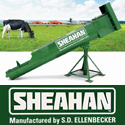 |
 |

|
|
|
National & World Ag News Headlines |
 |
Weather Impacting Sunflower, Prices in Production Areas
USAgNet - 07/20/2017
North Dakota's sunflower crop is beginning to bloom - 9 percent of the planted sunflower are reported blooming this week. And in Minnesota, the sunflower crop looks to be a good one - 89 percent of the crop is reported in good to excellent condition,
reports the National Sunflower Association (NSA).
South Dakota reports 100 percent of the crop is emerged, but mo of it rated poor to fair. In Kansas, 96 percent of the crop is emerged and 62 percent of it is good to excellent.
Banded sunflower moth has just started to emerge based on pheromone trapping data from IPM scouts in North Dakota. Sunflower is still in the late vegetative to R1 (terminal bud forms miniature floral head), so it is too early for scouting. Sunflower is
susceptible during the flowering period. Banded sunflower moth can be identified by its small size (1/4 inch long), and its forewings with a triangular, dark brown band across the middle of the wing. It is an economic insect pest of oil and confection sunflowers
and larvae feed and tunnel through the florets and developing seeds. Oil content of sunflower also can be reduced when moth populations are economic. Learn more about these insects on the NSA website.
Sunflower prices continue to move upward, gaining 25 to 30 cents this week at the crush plants. Nearby prices set a new market year high this week at $17.10. This represents $3.10 per cwt increase since the market low was set back in December.
Birdfood prices have also been on the rise in the past two weeks as processors compete for available seed supplies. Some locations are offering up to $19.00 for July delivery.
The hot and dry weather conditions affecting the Dakotas, the leading production areas, is giving support to seed prices. Sunflower is very drought tolerant and for the most part doing ok considering the growing conditions. However, rain will be needed soon as
the plants move from the vegetative to the reproductive stage. Forecasters give the region little chance of rain and continue to see temperatures above normal for much of the next two weeks.
USDA released a bearish soybean supply and demand report last week. USDA tightened ending stocks, however, yield estimates remained unchanged and the supply numbers remain big. This gave traders a negative signal and sent CBoT prices tumbling, NSA
reports.
Several weather forecasters are expecting the heat dome that's been leading to hot-weather advisories in the Midwest to move out of the central Corn Belt. A new system is following that and may bring some rain to areas that need it. Weather will control price
direction from this point onward.
|
 |


|
 |
|
Copyright © 2024 - Farms.com. All Rights Reserved. |
 |
|